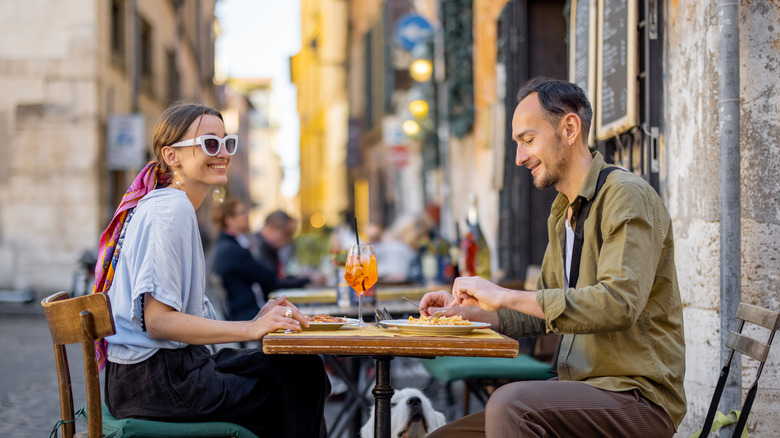
Rosshelen/Getty Images
Going on vacation has become seriously expensive, and it’s putting people off taking trips. A poll by SSRS, conducted in April 2025, found that nearly half of Americans were planning to do less international travel than they usually would. And for those who were planning to travel, around 48% were planning on taking a shorter or cheaper vacation.
If you’re among those who desperately want to get away and see the world, but don’t want to break the bank, it’s possible to have your cake and eat it, too. Just ask Rick Steves, one of the leading and most trusted voices on European travel. Steves knows that by making a few smart wallet-friendly food decisions, you can help your budget stretch further, leaving more money for activities and, well, everyday life when you get back home.
Keep reading to find 13 of Steves’ top budget food tips for hungry travelers. From packing a picnic to bagging up buffet breakfast leftovers to leaving the big cities behind, he’s got all bases covered.
Seek out local street markets and food stalls

Johnnygreig/Getty Images
Sure, a sit-down meal in a local restaurant is fun, but it’s not always the cheapest option, especially if you’re traveling to major well-known cities like New York, Paris, or London. If you’re traveling on a budget, meals for one or more people — especially if you go to out to eat more than once on your trip — are going to blow through your allotted spending money pretty quickly.
But don’t despair, because Rick Steves has the answer: Street markets. London alone is filled with must-visit food markets and food halls; a total of nearly 300 street markets in the English capital. But you can find these markets in many popular destinations across Europe, Africa, South America, and Asia. In his guide to the British hotspot specifically, Steves recommends popping to food stalls to sample the local cuisine over the more expensive sit-down restaurants.
As an added bonus, walking through a street market is also a fun way to soak up the culture. There are usually lots of different flavors and cuisines on offer, and sometimes a bit of street entertainment, too.
Pack a picnic
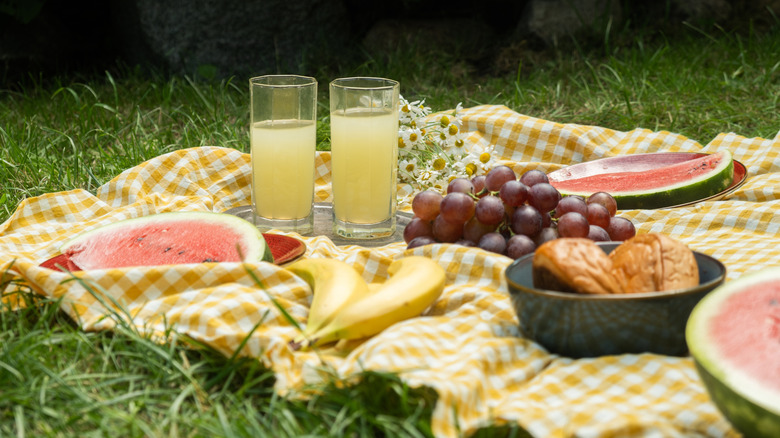
Meteoritka/Shutterstock
In countless guides on his website, Rick Steves recommends packing a picnic to bring with you on days out. It’s an incredibly simple and easy way to make sure you’re nourished during your vacation, and while it might sound like the slightly more boring option, it can actually be quite fun. There’s the chance to browse local grocery stores or markets and stock up on foods you might not usually choose or have access to. For example, in his guide to Iceland, Steves and his co-writers recommend taking a trip to a budget supermarket, like Krónan or Bónus, to stock up on Icelandic treats.
However, they also note that if you’re heading somewhere notoriously expensive — like Iceland – it might be worth filling your suitcase before you leave with a few favorite snacks from home to take on picnics, too. When shopping in a European grocery store, Steves recommends checking out options like the pre-made sandwiches, fruits, vegetables, and packets of cookies to keep the final cost down.
When you’ve got your stash of snacks, head to a local scenic spot or famous monument to enjoy your picnic. Wherever you are heading in the world, there will be a picnic spot waiting for you, and your budget will thank you for it. Just make sure beforehand that your planned picnic spot allows outside food onto the premises. Feeling a little tired? Steves promises there’s no shame in having a hotel room picnic, either.
Ask for tap water instead of paying for a drink with your meal

Syda Productions/Shutterstock
When you do decide to treat yourself to a restaurant meal, Rick Steves says there is one easy way to keep the bill down, and that’s to opt for a free glass of tap water. In Iceland, for example, servers won’t blink an eye at customers who ask for a free jug of water for the table. In fact, that’s pretty standard in most European countries, like the U.K., France, and Spain.
However, it’s important to do your research first before you assume that free tap water is available. In Germany, for example, tap water is safe to drink, but it’s not really customary to ask for it for free in a restaurant. If you do, you may be met with raised eyebrows, or worse, an extra charge on the final bill.
It’s also important to note that it’s actually not safe to drink tap water everywhere. If you’re heading to India, for example, it’s generally not advised for travelers to drink tap water. It’s the same for countries like Mexico, Sri Lanka, and Vietnam. In short: Tap water can be a great budget-saving solution, if it’s available. But do your research first before you drink it, as it could save you from a vacation-ruining bout of diarrhea.
Bag up leftovers from breakfast to take on day trips
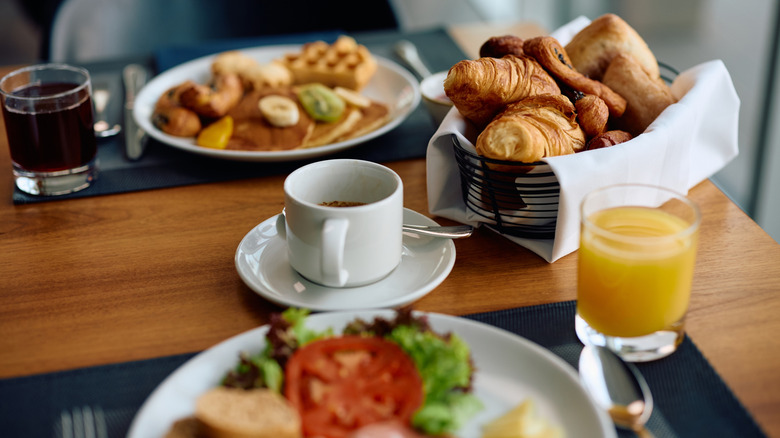
Drazen Zigic/Shutterstock
If you’re staying in all-inclusive accommodation, Rick Steves recommends taking advantage of all of that free food available to you, even when you’re out and about exploring. In an article about cruising the Mediterranean, the expert gives advice that can easily be transferred to any all-inclusive vacation: Eat a big breakfast, and then don’t be afraid to store some of the leftovers to eat later in the day. “It may not be classy,” he writes, “but it’s cheap.”
He also recommends opting out of specialty restaurants on cruise ships, which aren’t usually included in the price. Instead, head to the free dining hall to get the best value for money. And don’t worry, you won’t miss out on quality. According to one of Tasting Table’s experts on cruise ship dining – as a former cruise ship worker and frequent customer — the dining experiences on inclusive cruise lines like Disney and Royal Caribbean are usually pretty top-notch with plenty of tasty food available.
The best options to pop in your bag from breakfast are things like fresh baked goods and fruit. But before you start packing away a picnic with the breakfast items, make sure you know your accommodation’s policy. Some encourage guests to take things away with them from the breakfast buffet to reduce waste, while others might frown upon it.
Buy a pastry instead of paying extra for hotel breakfast
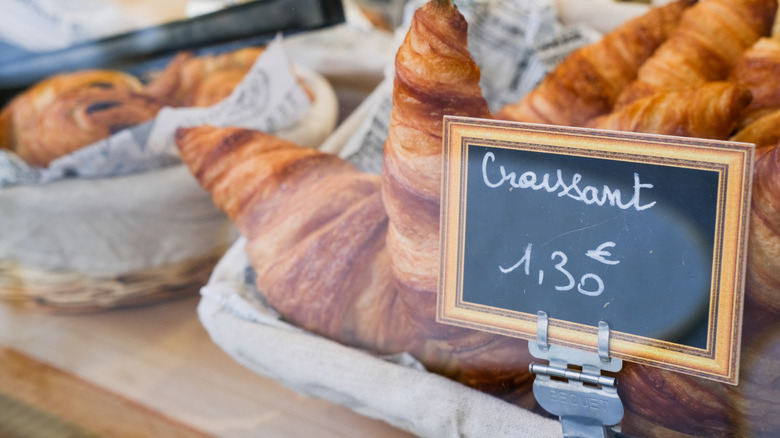
Elena Noviello/Getty Images
If breakfast isn’t included with your room price, then another great way to save money, according to Rick Steves, is to skip the hotel restaurant all together. In an article about eating on a budget in Italy, the travel expert notes that a much more authentic, and far cheaper option, is to head to a local bar for an espresso and a pastry. In Italy, coffee is usually drunk quickly standing at a counter. If you want to take your time and sit at a table, an Italian coffee-ordering etiquette tip is that you’ll likely have to pay a little more for the privilege.
Of course, Italy’s not the only destination with tasty, budget-friendly pastries. In a separate article focused on traveling on a budget in Europe, Steves recommends doing as the locals do and grabbing a croissant in France from a small patisserie or boulangerie. In Spain, he advises checking out corner bars and cafes for cheap breakfast deals.
While Steves’ advice is focused on Europe, the same applies in most places, whether you’re traveling in the U.S., Asia, or South America. The bottom line: Check out smaller cafes and bakeries before paying out for a big hotel breakfast.
Fill up on a lunch deal instead of an expensive dinner

Kala Studio/Getty Images
If you’ve got your heart set on trying out some of the pricier restaurants, Rick Steves has another good tip: Go at lunchtime. The expert notes that many of the more expensive establishments tend to offer cheaper deals in the middle of the day. This way, you still get to enjoy the food and the ambiance of a nice local restaurant, but without the major bill at the end of the meal. When dinnertime rolls around, that’s when it’s time to set up a cheap picnic or look for some street food.
If you do decide to eat in the evening, Steves advises that it’s worth looking out for fixed-price menu options. French restaurants, for example, tend to offer two options, à la carte or le menu. The former is just what you would expect: You’re given a menu and you choose anything you fancy from it. The latter, however, is usually a fixed multi-course meal, and you often get more value for your money by choosing this option.
Avoid tourist trap restaurants
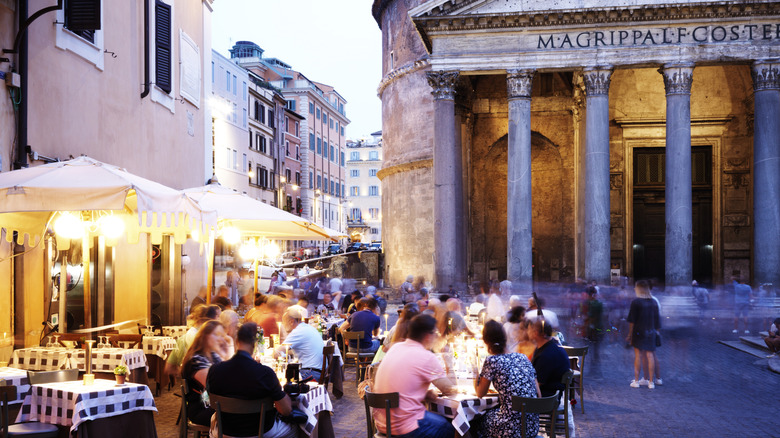
Gary Yeowell/Getty Images
If you’re walking through a bustling piazza or admiring a famous monument, it’s easy to fall into the trap of going to the nearest restaurant to you. But Rick Steves recommends thinking twice before you do this. Eateries in high-traffic, touristy areas tend to have much higher prices than restaurants that are a little further off the beaten track.
Those touristy restaurants also tend to rob you of a real cultural experience. Steves notes that in Tangier in Morocco, for example, many day-trippers from nearby Spain fall foul to extremely cliché restaurants in the high-tourist-volume eras, when there are many much nicer places to eat just a short walk away.
If you’re not sure if you’re about to walk into a tourist trap, Steves has a few secret tips to look out for to avoid falling for tourist traps. It’s a good idea to look for seasonal dishes, as tourist trap restaurants will usually serve famous dishes all year round, regardless of whether the ingredients are in season or not.
Look for handwritten menus
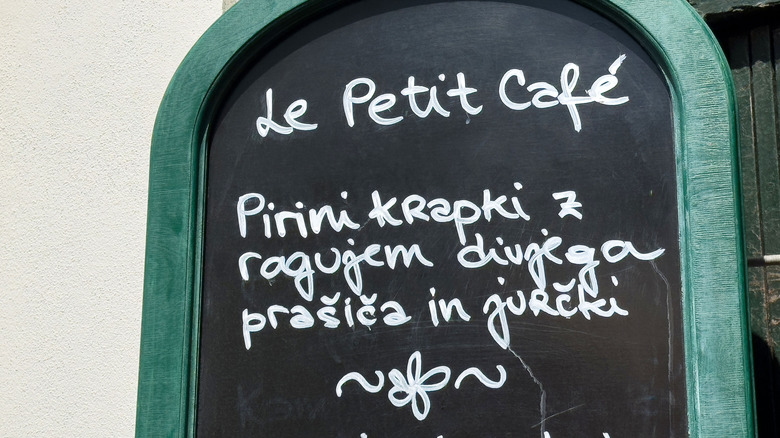
HelgaQ/Shutterstock
As well as seasonal ingredients and dishes advertised in the local language, Rick Steves confirms that another green flag of a good, reasonably-priced European restaurant is a handwritten menu. Places like this are usually smaller mom-and-pop eateries, and they’re not only cheaper, but they’re usually far more authentic, too, filled with locals instead of fellow tourists.
If the menu isn’t handwritten, this isn’t necessarily a red flag, of course. Steves advises that budget travelers look for simple, smaller menus, or menus that are printed with a date. This way, you’ll likely get better quality food for a reasonable price, rather than paying through the nose for an average out-of-season meal at a tourist trap restaurant.
At the same time, you’ll also be supporting the locals, which is not only more ethical, but more interesting and insightful, too. Steves is a big advocate for the fact that you can learn a lot about a new place through its people, after all.
Opt for takeout over dining in

Cultura Creative/Shutterstock
You don’t always have to dine in to enjoy delicious local foods. Rick Steves often points out that opting for takeout is usually the cheaper option. You can order from a local restaurant and then take your food with you as a picnic to enjoy in front of a nice view. In Italy, you can grab pizza rustica to-go in many places, for example, and in Germany, there are plenty of local sausage stands. In the U.K., a fish and chip shop is usually a good budget bet.
Steves also has some perhaps more slightly controversial advice: Don’t be afraid to order fast food. It’s not everyone’s thing, and it’s certainly not going to give you an authentic experience of a country, but chain restaurants like McDonald’s and Burger King are usually cheaper and relatively easy to find in most cities. You can also take advantage of the familiarity (a hamburger and fries is a hamburger and fries, wherever you are in the world), as well as the lack of cover charge and the free Wi-Fi, he notes.
Sit down at a bar that serves snacks with drinks
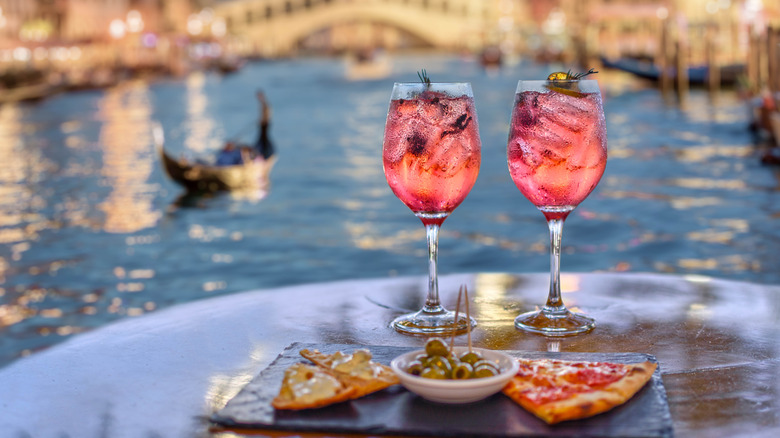
Lichtwolke/Shutterstock
If you’ve got time on your hands, arguably, one of the best ways to enjoy a new destination is to sit at a local bar, sip on a beverage, take in the scenery, and watch the world go by. One way to make this experience even better (and more budget-friendly)? Rick Steves has one word for you, the Italian tradition: aperitivo.
In Italy, it is customary to serve a few snacks for free when a person stops by the bar for an aperitivo (which is the tradition of having a drink or two to begin the evening). Usually, bars will supply a free bowl of nuts, a few olives, or some potato chips, but it entirely depends on where you are, as some bars tend to be more generous with the free food than others. Serving free snacks with drinks isn’t exclusive to Italy, either. This is also common in countries like Spain and Greece, too.
Choose accommodations with a kitchen

Piksel/Getty Images
If you’re booking your dream vacation, don’t fall into the trap of just looking at hotel sites. There are many different accommodation options available, including hostels. Yep, according to Rick Steves, hostels are no longer just for backpackers, they’re also a great choice for anyone looking to travel on a budget, as, among other things, most offer access to a communal kitchen. Even the higher end hostel options, nicknamed poshtels, come with shared access to cooking facilities.
Cooking for yourself is an easy way to keep food costs down. But hostels aren’t the only self-catering option available, of course. You can also keep an eye out for Airbnbs, farmhouses, and even glampsites, many of which will come with a private kitchen or offer access to shared cooking facilities.
That said, it’s not a given that if you’re renting or staying in an apartment or house you will always have everything you need to cook for yourself. Steves recommends sending a list of questions, including some about what’s available in the kitchen, before you make your booking.
Keep an eye out for happy hour pricing
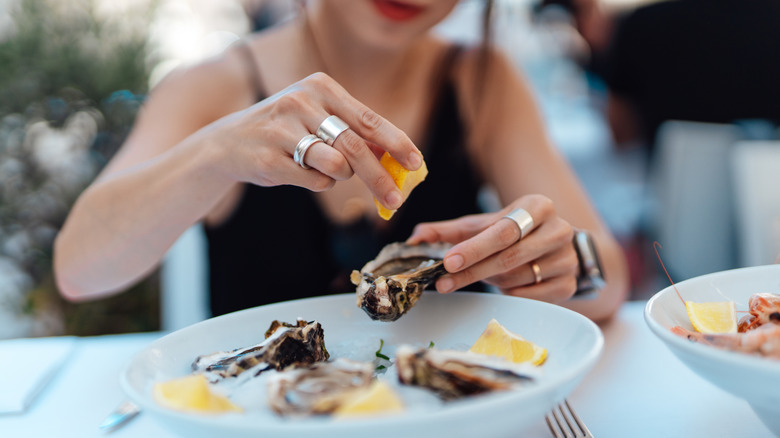
Oscar Wong/Getty Images
When you’re wandering through the streets, taking in the sights, and admiring the landmarks, keep an eye out for restaurant deals. According to Rick Steves, happy hour pricing is becoming more popular in European hotspots. Not just lunchtime deals, but also dinnertime and breakfast bargains, too. He notes that in Rome, for example, several bars are competing with each other to offer the best deals on buffet spreads.
London is also known for happy hour bargains. While most of the deals apply to beverages like cocktails, beer, and wine, there are also often a few limited time deals on food items, like pizza, croquettes, and even oysters. If you’re in Spain, look out for deals on tapas. In Barcelona, for example, you’ll often come across combo deals that offer tapas plates with a drink for a fixed, cheaper price.
Seek out restaurants in small towns over big cities when possible

Wera Rodsawang/Getty Images
Big cities are alluring for a reason. They offer a mix of culture, history, buzzy bars, and great restaurants. But they also tend to be on the pricey side, especially in Europe. Rick Steves’ advice? Explore the big city, sure, but don’t ignore the surrounding smaller towns and villages. These aren’t as heavily frequented by tourists, so the price for a nice meal out is likely to be far cheaper.
When you are dining in the big city, think carefully about what you choose to spend your money on, advises Steves. If you’re craving something sweet, but you’re still quite full from your main meal, consider ordering just one dessert to share. Another thing to think carefully about is how you get to your restaurant, as taxis can be expensive. If you’ve got time on your hands, don’t be afraid to make good use of public transport.


Dining and Cooking